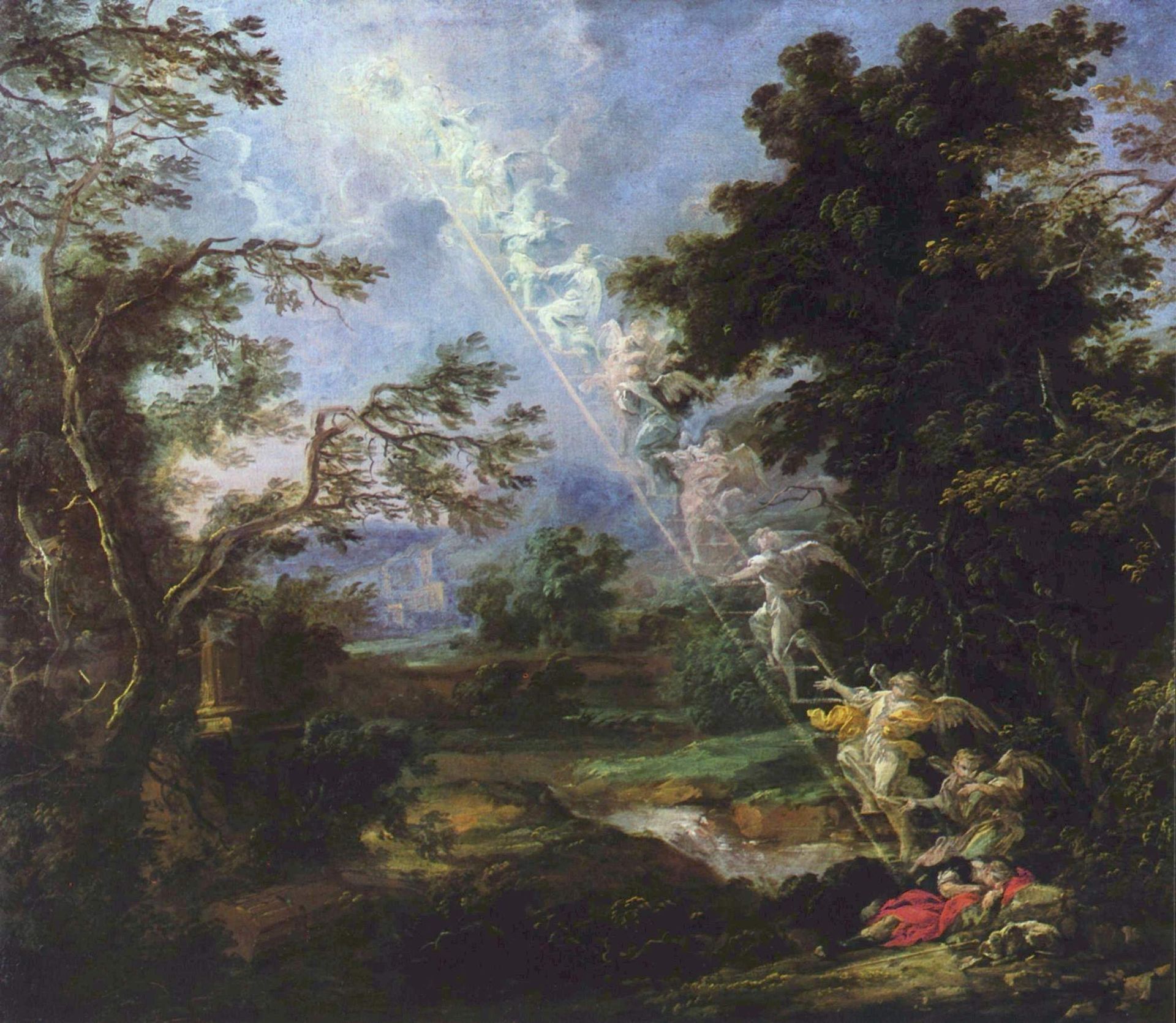November 19, 2018
And he [Jacob] dreamed, and behold! a ladder set up on the ground and its top reached to heaven; and behold, angels of G‑d were ascending and descending upon it. (Genesis 28:12)
Rabbi Shneur Zalman of Liadi (a.k.a Baal HaTanya, or the Alter Rebbe) once remarked in Yiddish, “lieben mit di tzait” – live with the time, meaning one should live with Torah portion of the week. Last week I was taught a lesson on how the current Torah portion affects my thinking, whether I know it or not.
Last week I shared with my wife, who is a biophysicist, that while thinking about system biology, I realized that all organisms – from a single cell to multicellular organisms – are Bayesian systems. I knew that the brain is a Bayesian engine, but I never heard of this concept being applied to other biological systems. This was a neat idea. This realization was a happy thought as it felt right and profound. Coincidentally, two days later, I found in my inbox a daily email from the Wired magazine. In this email, there was a link to an article The Genius Neuroscientist Who Might Hold the Key to True AI. It caught my interest, and I clicked on the link. And there it was.
But first, let me explain a bit about the Bayesian systems and Bayesian statistics. In 1763, the English mathematician, philosopher, and theologian Thomas Bayes published the theorem that now bears his name. Essentially, it evaluates the veracity of a hypothesis given the newly-acquired evidence.
Whereas frequentist interpretation of probability is based on the frequency of an outcome, the Bayesian probability is an interpretation of probability as a reasonable expectation, the state of knowledge or qualification of personal belief. The Bayes theorem is a method of updating probabilities, which are degrees of beliefs or assumptions, after obtaining new data. It links the degree of belief in a proposition before and after accounting for evidence. French mathematician Pierre-Simon Laplace further developed and popularized Bayesian probability. Bayesian ideas are used today, not only in mathematics and statistics, but in physics, medicine, economics, decision-making, artificial intelligence, machine learning, and many other fields.
Our brain acts like a Bayesian engine. Instead of reacting to our sensory input, it proactively predicts what to expect, based on prior experience, instincts, or beliefs, and acts in accord with these predictions. Every moment the brain compares its predictions with newly-acquired sensory inputs and adjusts its beliefs accordingly. In other words, we do not discover the world around us; instead, we project our belief in how the world around us ought to look and then check periodically to see if we are wrong about any of the details of our picture and adjust the picture accordingly. Talk about being presumptuous.
While it is reasonably well established that this is how the brain works, extending this notion to all forms of life is not so obvious and even counter-intuitive.

Karl Friston introduced the concept of free energy as the difference between the state the system is expected to be in and the state it is found in based on the sensory input. Minimizing free energy means minimizing surprise. Karl Friston posited that all forms of life—from a single cell to multicellular organisms—minimize free energy. In other words, all living organisms act as Bayesian systems minimizing the difference between the expected state and the actual state obtained from sensory input. Friston boldly states that this is the universal principle of life—to be alive means to be minimizing free energy.
For anyone interested in exploring these fascinating ideas further, I highly recommend reading the above-cited article.
Now, back to our Torah portion, Vayetzei. We read in this parashah about the Jacobs dream when he sees a ladder connecting heaven and earth with angels going up and down the ladder. There are many interpretations of this dream. I’d like to focus on one of them.
According to the Midrash Rabba (Genesis 28:12), the angels were going up the ladder to see the celestial image of Jacob engraved on Kisei HaKavod – the Throne of Glory. There they saw Jacob in his lofty state worshiping his Creator. Going down the ladder with this image in mind, they encountered the terrestrial Jacob sleeping on the place where the Holy of Holies in the Jerusalem Temple would be built by his descendants. The angels were surprised, to say the least. In fact, they were aghast and intended to harm Jacob, if not for his awaking from his sleep that very moment.
In my essay, “Abraham Meets Abraham from a Parallel Universe,” I discussed terrestrial Abraham meeting celestial Abraham in the Torah portion Vayera. The former did not recognize the latter, as Abraham did not look exactly like his celestial counterpart.
The angels ascending the ladder looked for the celestial image of Jacob to know what to expect. When they compared that lofty image with physical Jacob sleeping on the ground, they were surprised by the difference. Just as the Bayesian brains compare their expectations to their sensory input, the angels compared their expectations with what they saw. They acted as truly Bayesian angels.
It seems that the principle formulated by Karl Friston that all forms of life are Bayesian, that is, they minimize free energy, includes not only physical life but angelic beings as well.
A story is told that while in prison in St. Petersburg,[1] Rabbi Schneur Zalman, the Alter Rebbe, was visited by one of Tsar’s ministers, who was a very educated man. He asked the Alter Rebbe to explain to him the meaning of the word ayekah (“where are you”) at the beginning of the Torah:
And the Lord G‑d called to man, and He said to him, “Where are you (Ayekah)?” (Genesis 3:9)
The Alter Rebbe told him the explanation according to Rashi. The minister stopped the Alter Rebbe, saying that he knew Rashi’s explanation and wanted to know the Rebbe’s explanation. The Alter Rebbe told his visitor that when G‑d asked Adam where he was—Ayekah?—the Omniscient G‑d knew Adam’s whereabouts. G‑d was really asking Adam, Where Adam was relative to his true potential.[2] When the later Rebbes of Chabad retold this story, they emphasized that Alter Rebbe’s lesson was that G‑d asks each one of us—Ayekah? —Where are you relative to your true potential?
G‑d taught Jacob this great lesson in the dream. The angels of judgment constantly compare each of us with our “heavenly image”—our true potential—and judge us based on how short we fall of our potential.
But then, perhaps the angels are really us, for we all know (or, at least, have an inkling) of our true potential. Every day we compare ourselves to our ideal selves, to our image of self. We ask ourselves, Where are we relative to our potential? If we fall far short, we may suffer from frustration, disappointment, and cognitive dissonance. With apologies to Oliver Perry’s famous quote,[3] we have met the angels, and they are us.
The deep insight of Karl Friston positing that life is minimizing free energy—the difference between the expected state and the actual state—may even be more profound. It is not only the biological principle of life but, indeed, the meaning of life—to minimize the shortfall between our potential and our present state, that is, to strive to realize our true potential.
Endnotes:
[1] The Alter Rebbe was falsely accused of High Treason. He was not only completely exonerated, but decrared an Honorary Citizen of Russia. See A. C. Glitzenstein, “The Arrest and Liberation of Rebbi Shneur Zalman of Liadi: The History of Yud-teth Kislev,” (Kehot Publication Society, NY, 1964).
[2] The story goes that the Alter Rebbe actually told the minister “Where Adam was at such-and-such age,” and he named the exact age of the minister, whose birthday was that day.
[3] During the War in Canada, in 1813, after the stunning victory on Lake Erie, defeating and capturing Royal Navy ships American naval officer, Commodore Oliver Hazard Perry sent his famous dispatch to Major General William Henry Harrison: “We have met the enemy and they are ours. Two ships, two brigs, one schooner and one sloop.” This quote is often shortened as “We have met the enemy and they are us.”


Fascinating! Thanks!